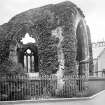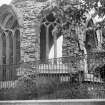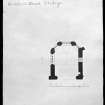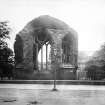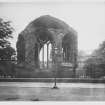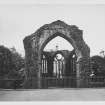St Andrews, South Street, Blackfriars' Chapel
Chapel (16th Century)
Site Name St Andrews, South Street, Blackfriars' Chapel
Classification Chapel (16th Century)
Alternative Name(s) Dominican Monastery
Canmore ID 34336
Site Number NO51NW 5
NGR NO 50764 16565
Datum OSGB36 - NGR
Permalink http://canmore.org.uk/site/34336
- Council Fife
- Parish St Andrews And St Leonards
- Former Region Fife
- Former District North East Fife
- Former County Fife
NO51NW 5.00 50764 16565
NO51NW 5.01 5075 1654 Monastery
(NO 50751654) Black Friars' Chap (NR) (Remains of)
Black Friars' Monastery (NR) (AD 1274) (Site of).
OS 25" map (1914)
See also St Andrews, South Street, Madras College (NO51NW 273: NO 50773 16438).
The house of Black Friars was founded by Bishop Wishart (1272-1279). The construction of the chapel or aisle (the sole remains) was authorised by Archbishop Beaton in 1525. The house was sacked in June 1559. The remaining portion of the church lies within the grounds of Madras College. It measures internally 26ft N-S by 21ft E-W. It is apsidal-ended and has originally had radial buttresses.
RCAHMS 1933
The remains of the chapel are as described above, and are in a fair state of preservation.
Visited by OS (JLD) 16 October 1956
The condition of the remains of the chapel is unchanged. No trace of the Monastery remains.
Visited by OS (WDJ) 29 May 1964
NO51NW 5.00 50764 16565
REFERENCE:
NATIONAL LIBRARY OF SCOTLAND
'Scots Magazine', Dec 1808, engraving by H W Williams
Field Visit (25 July 1926)
The Blackfriars Chape1.
Within the grounds of the Madras College and facing South Street is the ruin of the north aisle of the Dominican Church, the only part of the building that has survived. This aisle was built in 1525 (see HISTORICAL NOTE) and is a fairly typical specimen of late Gothic design. It measures internally 26 feet from north to south by 21 feet from east to west. It is apsidal-ended and has originally had radial buttresses. In each of the three apse-walls and in the main west wall is a mullioned window, the tracery of the lights in the apse being modern. The hoods are enriched with floral paterae. The roof is a pointed barrel-vault of ashlar with surface ribs meeting at a central circular boss having the form of a shield on which, within a tressure, are the emblems of the Passion- two hands, two feet, the heart pierced with a spear, three nails, and a dice-box. The ribs spring from corbel-stops and shafts, and three of the corbel stops bear the Hepburn arms, probably those of John Hepburn, Prior of the Augustinian Convent of St. Andrews. The arch through which the aisle opened into the church is built in two chamfered orders, the jambs having simply moulded imposts and bases. In the south-east angle is an aumbry, giblet-checked, with a traceried head. From excavations made by the St. Andrews Antiquarian Society inI909 the width of the church was ascertained to be 25 feet. The necessary steps to preserve the aisle have been taken by H.M. Office of Works, who are now its custodians.
HISTORICAL NOTE. - Bishop Wishart (1272-1279) founded and endowed the house of Black Friars. By the beginning of the 16th century the revenues had so decreased and the buildings become so dilapidated that the establishment was reduced to a single friar. However, in 1516, by using a legacy from Bishop Elphinstone and appropriating three years later the revenues of the Convents at Cupar and St. Monans, which were suppressed, the house was restored to its earlier importance. In 1525 Archbishop James Beaton gave the Friars permission to build the aisle or chapel, which is now all that remains, ten feet out upon the street "becauss thaira wne rowme betwix thair said northe wall and thair kirk is not sufficient and lairge for the lenthe of the yle foirsaid." The house of Black Friars was among those sacked in June 1559, so that, according to one account, "there wes never inch standing bot bare walls."" In the earlier part of the 19th century the western part of the monastic building, known as the "Old Palace" with its arched doors and wide stairs, served as a dwelling-house, but that part was cleared away." – Hay Fleming's Handbook to St. Andrews, pp. 12-13.
RCAHMS 1933, visited 25 July 1926.





















































